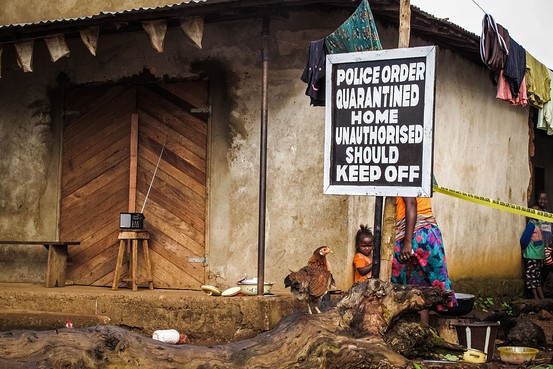Ebola Cases Cross 10,000
A home is quarantined in Port Loko, Sierra Leone, one of the three West African countries at the

NEW DELHI: In its latest report on the ebola outbreak, the World Health Organisation (WHO) has said that the number of ebola cases have crossed 10,000 with 4,922 deaths.
Only 27 cases have occurred outside of the three worst affected countries -- Sierra Leone, Liberia and Guinea, which also account for all but 10 of ebola fatalities.
The situation report says that Liberia remains the worst affected country, with 2,705 deaths. Sierra Leone has had 1,281 fatalities and there have been 926 deaths related to the ebola virus in Guinea.
(Source: WHO)
Following the WHO Ebola Response Roadmap structure, country reports fall into two categories: 1) those with widespread and intense transmission (Guinea, Liberia, and Sierra Leone); and 2) those with or that have had an initial case or cases, or with localized transmission (Mali, Nigeria, Senegal, Spain, and the United States of America).
(Source: WHO)
(Source: WHO)
The report says that a total of 450 health-care workers (HCWs) are known to have been infected with the ebola virus disease (EVD): 80 in Guinea; 228 in Liberia; 11 in Nigeria; 127 in Sierra Leone; one in Spain; and three in the United States of America. A total of 244 HCWs have died.
EVD is a virus with a high fatality rate that was first discovered in 1976. Ebola hemorrhagic fever is the disease cause by one of five different Ebola viruses, with the fifth virus, Reston virus, causing illness in some animals but not humans.
The Ebola virus is extremely infectious but not, contrary to popular perception, extremely contagious. This means that even though an infinitely small amount of the virus can cause illness, it does not spread through air and only through contact with bodily fluids or contaminated objects from infected persons or animals.
The virus can incubate up to 21 days before symptoms appear, although the typical incubation period lasts eight to ten days. Symptoms include weakness, fever, aches, diarrhea, vomiting, stomach pain, rashes, red eyes, chest pain, throat soreness, and difficulty breathing.
This current outbreak is the deadliest ebola outbreak in history.
In the picture above, ebola to leave a Doctors Without Borders treatment center after recovering from the virus in Paynesville, Liberia (via CNN).
A woman, suspected of having contracted the ebola virus, waits to be taken to a health facility (via AP).
A healthcare worker sprays disinfectant in the area they found a man suspected of suffering from the Ebola virus in Kenema, Sierra Leone (via AP).
A woman crawls toward the body of her sister as a burial team takes her away for cremation in Monrovia, Liberia (via CNN).
A health worker in protective clothing holds a child suspected of having Ebola in the Paynesville treatment center (via CNN).
A girl cries as community activists approach her outside her Monrovia home on Thursday, October 2, a day after her mother was taken to an Ebola ward (via CNN).
A member of the CG Environmental HazMat team disinfects the entrance to the residence of a health worker at the Texas Health Presbyterian Hospital who has contracted Ebola in Dallas, Texas, October 12, 2014 (via RT).
Marie Nyan, whose mother died of Ebola, carries her 2-year-old son, Nathaniel Edward, to an ambulance in the Liberian village of Freeman Reserve (via CNN).
A medical worker disinfecting his hand with chlorine at Doctors Without Borders treatment center in Kailahun, Sierra Leone (via NPR).



